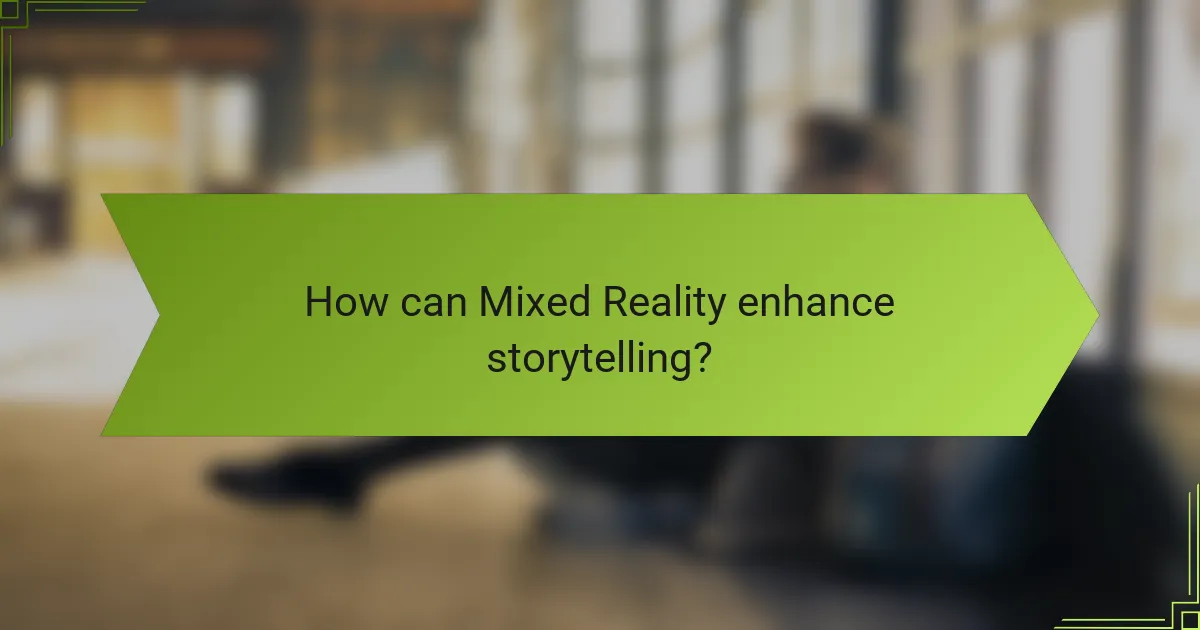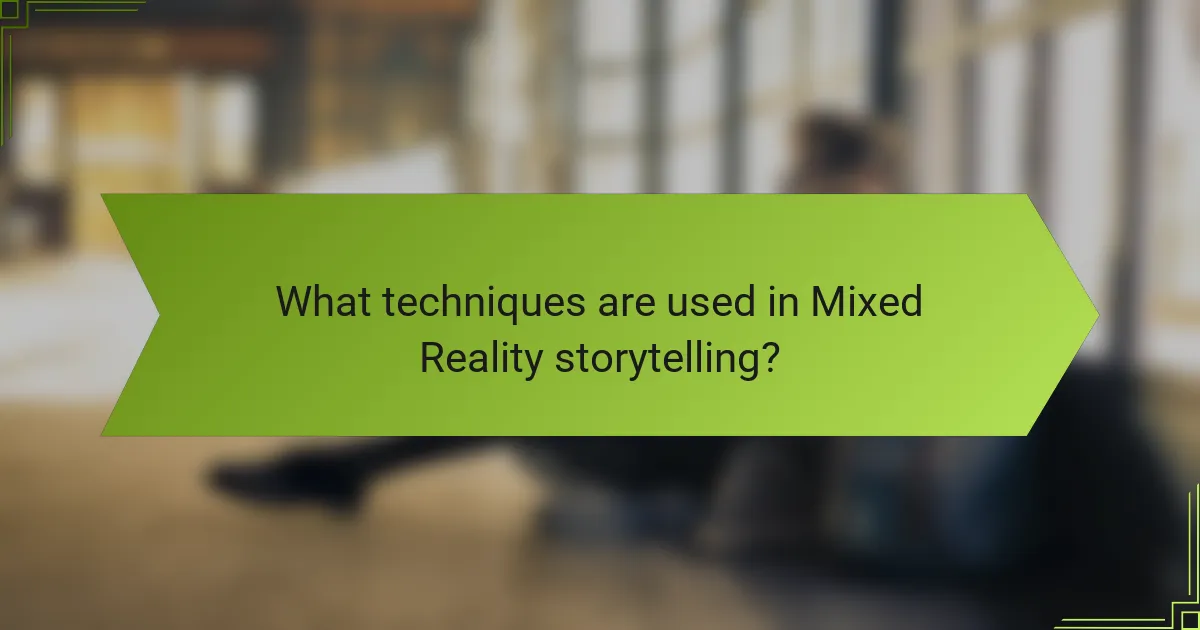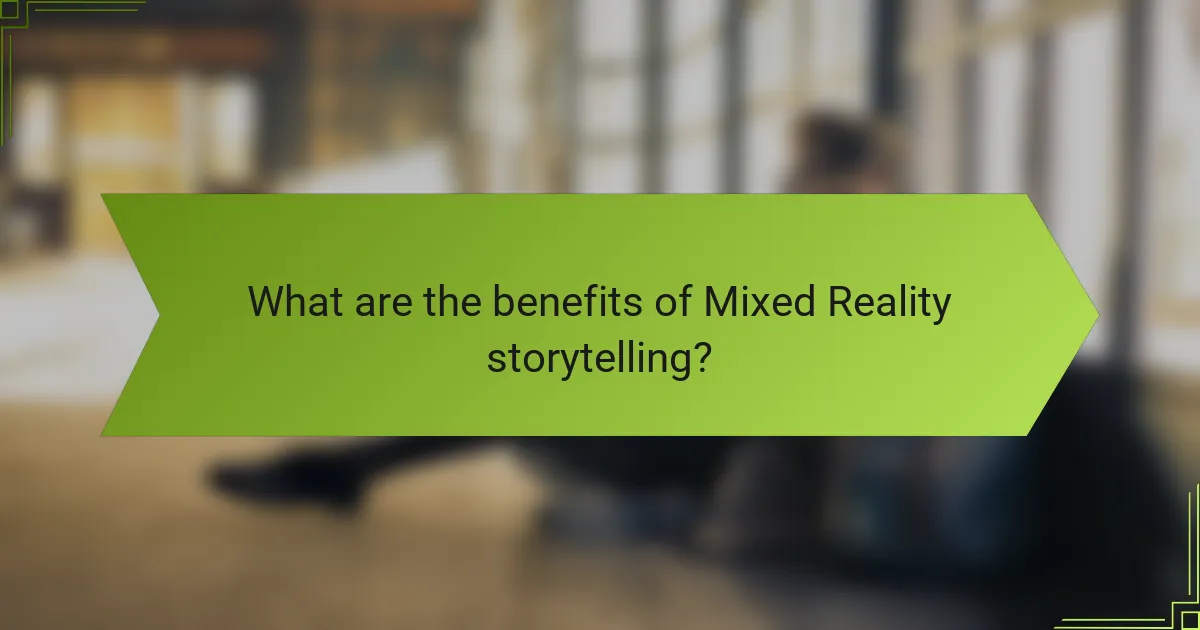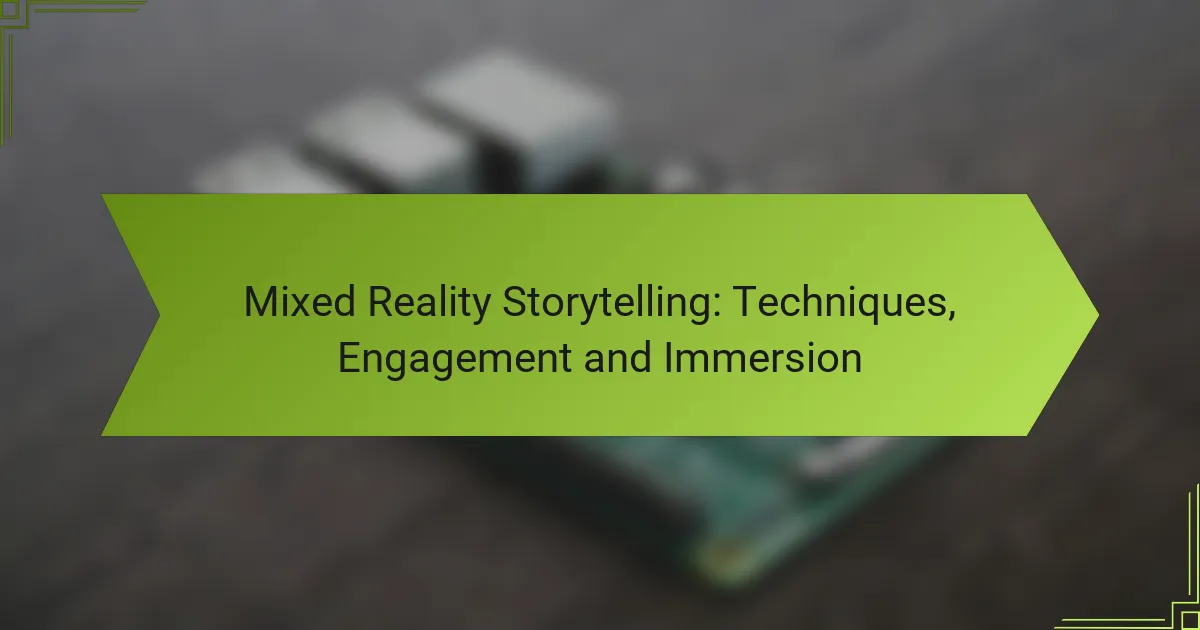Mixed Reality (MR) storytelling revolutionizes the way narratives are experienced by seamlessly integrating digital content with the physical environment. This innovative approach not only enhances engagement but also fosters deeper immersion, allowing audiences to interact with stories in unprecedented ways. Techniques such as Augmented Reality overlays and Spatial audio further enrich the storytelling experience, making it emotionally resonant and memorable.

How can Mixed Reality enhance storytelling?
Mixed Reality (MR) enhances storytelling by blending digital content with the physical world, creating a more engaging and immersive experience for audiences. This technology allows storytellers to craft narratives that are interactive and visually captivating, drawing viewers deeper into the story.
Increased audience engagement
Mixed Reality significantly boosts audience engagement by allowing viewers to interact with the story environment. This interaction can take many forms, such as manipulating objects or influencing the narrative direction, which keeps the audience invested in the experience.
For instance, in a MR storytelling experience, users might be able to choose different paths for characters or solve puzzles that affect the storyline. This level of participation can lead to a more personal connection with the narrative.
Immersive experiences
Immersive experiences in Mixed Reality transport audiences into the narrative world, making them feel as though they are part of the story. By using spatial audio, 3D visuals, and haptic feedback, MR creates a sensory-rich environment that enhances emotional responses.
For example, a horror story in MR can utilize sound effects that seem to come from specific directions, increasing tension and fear. Such immersive techniques can elevate storytelling beyond traditional media, making it more impactful.
Interactive narratives
Interactive narratives in Mixed Reality allow audiences to influence the story’s outcome through their choices and actions. This interactivity can lead to multiple storylines and endings, providing a unique experience each time.
Storytellers can design branching narratives where decisions lead to different consequences, encouraging viewers to explore various paths. This approach not only enhances replayability but also fosters a deeper understanding of the characters and themes involved.

What techniques are used in Mixed Reality storytelling?
Mixed Reality storytelling employs various techniques to create engaging and immersive experiences. Key methods include Augmented Reality overlays, Virtual Reality environments, and Spatial audio integration, each contributing uniquely to the narrative experience.
Augmented Reality overlays
Augmented Reality (AR) overlays enhance storytelling by superimposing digital elements onto the real world. This technique allows users to interact with characters and objects in their immediate environment, creating a seamless blend of reality and fiction.
For effective AR storytelling, consider the context and placement of digital elements. Ensure that overlays are relevant to the narrative and do not obstruct the user’s view of the physical world. Examples include interactive maps or character animations that respond to user actions.
Virtual Reality environments
Virtual Reality (VR) environments immerse users in fully digital worlds, allowing for a deeper connection to the story. Users can explore these environments in 360 degrees, engaging with the narrative through movement and interaction.
When designing VR experiences, focus on creating intuitive controls and realistic interactions. Users should feel a sense of presence, which can be achieved through detailed graphics and responsive feedback. Common pitfalls include overwhelming users with too much information or complex navigation.
Spatial audio integration
Spatial audio integration enhances the immersive quality of Mixed Reality storytelling by providing sound that changes based on the user’s position and orientation. This technique helps to create a more believable environment, as sounds can come from specific directions, mimicking real-life acoustics.
To effectively implement spatial audio, ensure that sound effects and dialogue are well-mixed and contextually appropriate. Use audio cues to guide users through the narrative, but avoid excessive noise that could distract from the experience. Testing audio in various environments can help fine-tune the experience for different users.

What are the benefits of Mixed Reality storytelling?
Mixed Reality storytelling offers unique advantages that enhance user engagement and immersion. By blending digital content with the real world, it creates experiences that are emotionally resonant, memorable, and accessible to a wider audience.
Enhanced emotional connection
Mixed Reality storytelling fosters a deeper emotional connection by immersing users in interactive narratives. Participants can engage with characters and environments in ways that traditional media cannot replicate, making the experience feel personal and impactful.
For instance, a user might find themselves in a virtual scene where they can interact with a character’s emotions, leading to a stronger empathetic response. This level of engagement can evoke feelings that resonate long after the experience ends.
Improved retention of information
Users are likely to retain information better when it is presented through Mixed Reality storytelling. The combination of visual, auditory, and kinesthetic elements helps reinforce learning by engaging multiple senses simultaneously.
Studies suggest that interactive experiences can improve information retention rates significantly compared to passive consumption. For example, participants in a Mixed Reality educational program may recall facts and concepts more effectively than those who only read or watched videos.
Broader audience reach
Mixed Reality storytelling can attract a diverse audience by appealing to various interests and demographics. Its interactive nature makes it suitable for different age groups and backgrounds, enhancing its accessibility.
By incorporating elements that cater to various preferences—such as gamification, educational content, or artistic expression—creators can engage a wider range of users. This inclusivity can lead to increased participation and a more vibrant community around the narrative.

How do you choose the right Mixed Reality tools?
Choosing the right Mixed Reality (MR) tools involves evaluating user experience, platform compatibility, and content creation capabilities. These factors ensure that the selected tools effectively engage users and deliver immersive storytelling experiences.
Evaluate user experience
User experience (UX) is critical in Mixed Reality as it directly impacts engagement and immersion. Assess how intuitive the interface is and whether the tools provide seamless interactions. Look for tools that offer user-friendly navigation and responsive feedback to enhance the overall experience.
Consider conducting user testing with a small group to gather feedback on usability. This can help identify any pain points or areas for improvement, ensuring that the final choice aligns with user expectations and preferences.
Consider platform compatibility
Platform compatibility is essential when selecting Mixed Reality tools, as different devices and operating systems may support varying features. Ensure that the tools you choose are compatible with the devices your target audience uses, such as headsets, smartphones, or tablets.
Research the ecosystems of popular MR platforms like Microsoft HoloLens, Oculus, or Magic Leap. This will help you understand which tools are optimized for specific hardware, ensuring a smoother integration and better performance.
Assess content creation capabilities
The ability to create engaging content is a key factor in choosing Mixed Reality tools. Look for platforms that offer robust content creation features, such as 3D modeling, animation, and scripting capabilities. These features will enable you to craft immersive narratives that resonate with your audience.
Evaluate whether the tools support collaboration among creators, as this can enhance the development process. Tools that allow multiple users to work together can lead to richer and more diverse storytelling experiences. Additionally, consider the learning curve associated with each tool, as some may require more time to master than others.

What are the challenges in Mixed Reality storytelling?
Mixed Reality storytelling faces several challenges that can hinder its effectiveness and reach. Key issues include technical limitations, high production costs, and user accessibility concerns, each impacting how stories are created and experienced.
Technical limitations
Technical limitations in Mixed Reality (MR) storytelling primarily stem from hardware and software constraints. Devices may struggle with processing power, leading to latency issues that disrupt immersion. Additionally, the quality of graphics and tracking capabilities can vary significantly, affecting the overall experience.
For instance, many MR headsets have limited field of view and resolution, which can detract from the storytelling experience. Developers must optimize their content to work within these constraints, often sacrificing complexity for smoother performance.
High production costs
High production costs are a significant barrier to creating Mixed Reality content. Developing immersive experiences often requires specialized skills and technology, which can lead to expenses in the tens of thousands of dollars. This financial burden can limit the number of creators able to produce high-quality MR stories.
Moreover, ongoing maintenance and updates for MR applications can add to the costs. Budgeting for these factors is crucial for creators aiming to sustain their projects over time.
User accessibility issues
User accessibility issues in Mixed Reality storytelling can prevent a broader audience from engaging with the content. Many MR experiences require specific hardware, which may not be affordable or available to all users. This creates a digital divide that can exclude certain demographics.
Additionally, users with disabilities may find it challenging to interact with MR environments. Developers should consider inclusive design practices, such as customizable controls and alternative navigation methods, to enhance accessibility for all potential users.

How is Mixed Reality storytelling applied in marketing?
Mixed Reality (MR) storytelling enhances marketing by creating immersive experiences that engage consumers on a deeper level. Brands leverage MR to blend digital content with the real world, allowing customers to interact with products and narratives in innovative ways.
Brand experiences
Mixed Reality storytelling transforms brand experiences by allowing consumers to engage with a brand’s identity in a virtual space. For instance, a fashion brand might create an MR experience where users can virtually try on clothes, enhancing emotional connection and brand loyalty.
To maximize impact, brands should focus on creating relatable narratives that resonate with their target audience. This can include interactive elements that encourage users to share their experiences on social media, amplifying reach and engagement.
Product demonstrations
MR storytelling is particularly effective for product demonstrations, as it allows potential customers to visualize and interact with products in a realistic environment. For example, automotive companies can use MR to let users explore vehicle features in a virtual showroom, providing a hands-on experience without the need for physical inventory.
When implementing MR for product demos, ensure the experience is intuitive and highlights key features. Avoid overwhelming users with too much information at once; instead, guide them through the experience step-by-step, making it easy to understand the product’s benefits.
